The Ultimate Guide to Dremel Diamond Sanding Drums


Intro
Dremel diamond sanding drums have emerged as essential tools for enthusiasts in the realms of collectibles, rocks, and fossils. These drums, equipped with diamond particles, enable users to efficiently shape, smooth, and refine materials. Understanding the intricacies of these tools enhances their usability and effectiveness, particularly for those who engage with delicate or precise projects.
This guide delves into the various applications, advantages, and maintenance practices related to Dremel diamond sanding drums. It aims to provide insights that benefit not only novices but also seasoned craftsmen. By exploring selection criteria, types, and usage techniques, this piece will elevate the reader's proficiency with these vital instruments.
Featured Collectible of the Month
Overview
The featured collectible of this month showcases a unique fossilized coral specimen. Fossilized corals provide a glimpse into ancient marine ecosystems. They display intricate patterns and colors, making them prized among collectors. Among different kinds, Solenopora coral stands out with its distinct tubular structures and variations in density. These characteristics not only make it visually appealing but also present unique challenges for preservation and display.
Historical Significance
Fossilized coral dates back millions of years, serving as crucial indicators for understanding geological history. The significance of these specimens lies not solely in their aesthetic appeal but also in the information they hold regarding past climates and marine environments. Collectors equipped with Dremel diamond sanding drums can restore these fossils, revealing details and textures that may have remained hidden. Through careful sanding and polishing, the collector can breathe new life into these ancient relics, transforming them into valued pieces for education and display.
Identification Techniques
Visual Characteristics
Identifying fossilized coral requires careful observation. Look for the following visual traits:
- Color variation: Coral can range from soft beige to deep brown or even vibrant reds and greens.
- Pattern: The external structure often shows a unique, radiating pattern characteristic to specific types of coral.
- Texture: Feel for subtle ridges or grooves that signify the fossil's age and preservation quality.
Resources for Identification
Several resources aid in identifying fossilized corals:
- Wikipedia
- Britannica
- Specialized forums on Reddit can provide community insights and advice on identification.
- Engaging with groups on Facebook focused on fossil and rock collections can yield valuable information and support.
"Proper use of diamond sanding drums can enhance the beauty of fossilized specimens, drawing out their natural characteristics and historical value."
In summary, this guide aims to enrich your understanding of Dremel diamond sanding drums, focusing on effective use in collectibles, rocks, and fossils. Through careful maintenance and application, these tools can elevate your collection and craftsmanship.
Preface to Dremel Diamond Sanding Drums
Dremel diamond sanding drums are invaluable tools in the realm of precision sanding. For collectors of rocks and fossils, these tools offer significant advantages. They allow for fine detail work which is often required to restore and refine delicate pieces. Understanding these sanding drums brings insight into their applications, benefits, and the best practices for their effective use.
A primary consideration when using Dremel diamond sanding drums is the materials they effectively work with. These sanding drums are particularly suitable for harder materials, which often present challenges when using standard sanding tools. The diamonds embedded within the sanding drums make them robust and capable of tackling tough surfaces, ensuring a polished finish that enhances the appearance of the materials.
In this section, we will define exactly what Dremel diamond sanding drums are and discuss why they are favored in various applications, especially in rock and fossil collection.
What is a Dremel Diamond Sanding Drum?
A Dremel diamond sanding drum is a specialized abrasive tool designed for use with Dremel rotary tools. It features a cylindrical shape covered with diamond particles. These particles provide a superior grinding and sanding capability compared to traditional sandpaper. This design enables users to perform intricate sanding tasks with precision and control.
The construction of these sanding drums varies, but their primary feature is the layer of industrial-grade diamonds. This allows them to maintain their effectiveness over extended periods, even when used on hard materials like ceramics and stone. Thus, their utility extends beyond simple sanding; they can shape, smooth, and refine surfaces with ease.
Why Use Diamond Sanding Drums?
There are several reasons why diamond sanding drums are highly regarded among users, especially those dealing with collectibles, rocks, and fossils.
- Durability: The diamond particles are not only tough but also wear-resistant. They last significantly longer than standard abrasives.
- Versatility: These drums can be used on a variety of materials including metals, wood, ceramics, and stone, making them suitable for diverse applications in collections.
- Precision: The design allows for detailed work. Users can achieve fine sanding in tight spaces or intricate shapes with relative ease.
- Efficiency: The aggressive cutting action of diamonds means that tasks can be completed faster than with traditional sanding methods.
In summary, using Dremel diamond sanding drums combines efficiency, precision, and durability—three pillars that are especially important for rock and fossil collectors looking to preserve and enhance their valuable collections.
Understanding the Structure
Understanding the structure of Dremel diamond sanding drums is crucial for users looking to maximize their efficiency and effectiveness. The unique construction of these tools not only influences their performance but also determines their suitability for specific tasks, especially in the context of collectibles, rocks, and fossils. Knowing what materials are used and how the designs can vary helps users tailor their approach to sanding and finishing.
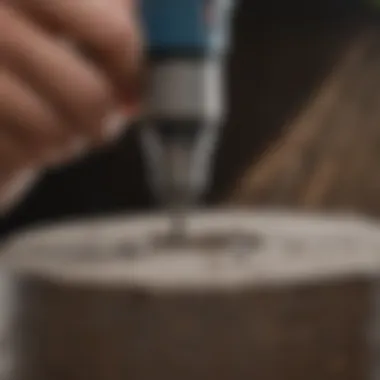
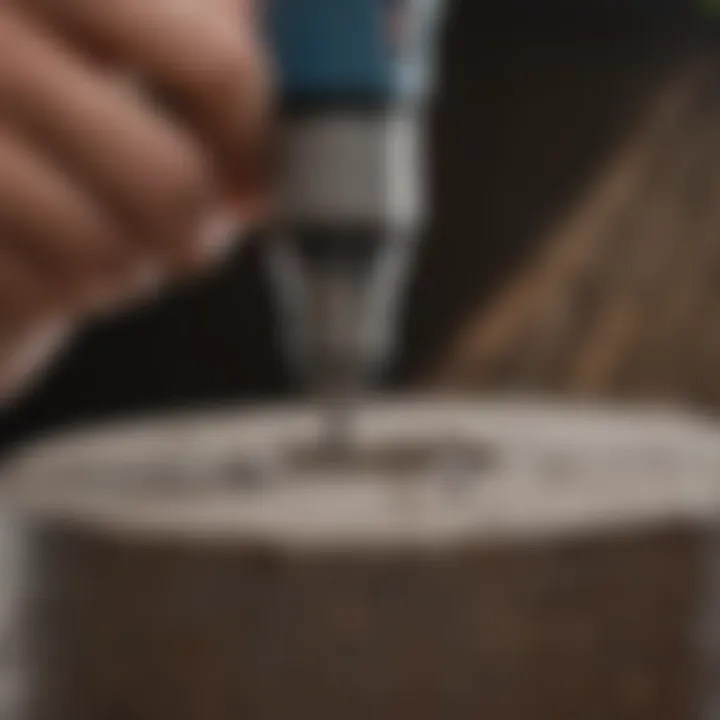
Materials Used in Diamond Sanding Drums
Dremel diamond sanding drums are primarily constructed from high-quality, durable materials. The core of these drums is typically made from a sturdy metal, which provides stability and strength during use. This metal core is crucial, as it allows the drum to withstand the high speeds and pressure often required in sanding tasks.
The most distinctive feature is the diamond coating. Diamonds are used due to their hardness and durability, making them ideal for sanding and grinding hard materials. This coating usually adheres to the surface of the drum in a layered manner. The quality and distribution of these diamonds directly impact their cutting capability and longevity. Users should look for drums with a uniform diamond distribution for optimal performance.
Additionally, the grit size of the diamond particles lends itself to varying applications. Coarser grits are useful for aggressive material removal, while finer grits provide smoother finishes. Therefore, understanding the materials and their implications for your projects is essential.
Design Variations
The design of Dremel diamond sanding drums comes in different forms, tailored to specific needs. The typical drum shape allows for easy access to intricate designs and tight spaces, critical for tasks involving detailed work on fossils or collectibles. However, variations include various diameters and profiles, which can enhance usability depending on the material being worked on.
For instance, some drums may feature a tapered design. This shape can be advantageous in reaching corners and edges that are difficult to sand with standard shapes. Others may have a longer design, allowing for more surface area contact, which can be helpful for quicker material removal on larger pieces.
There are also specialized designs for different materials. Some drums may be optimized for softer materials like wood, while others are made specifically for hard materials, including stone or metal. Choosing a suitable design variation can make the difference between a successful project and a frustrating one.
Understanding the structure of diamond sanding drums allows collectors and hobbyists to choose the right tool that matches their specific needs, ensuring better results and longer-lasting materials.
Types of Dremel Diamond Sanding Drums
Understanding the types of Dremel diamond sanding drums is essential for anyone aspiring to master the craft of polishing and shaping materials. This section will elucidate the different categories of sanding drums, focusing on their unique features, advantages, and practical applications. The choice of drum can significantly influence the outcome of a project, making informed decisions paramount.
Standard Diamond Drums
Standard diamond drums are the most commonly used type in various applications. They come in several sizes and grit options, providing versatility for many tasks. Typically constructed with a solid core covered in diamond grit, these drums are effective for tasks such as smoothing, shaping, and contouring surfaces.
Benefits of Standard Diamond Drums:
- Versatility: Suitable for a wide range of materials, including wood, metal, and stone.
- Efficiency: The diamond grit allows for quicker material removal compared to other sanding options.
- Durability: High wear resistance ensures a long lifespan, making them a cost-effective choice.
When selecting standard diamond drums, consider the grit. Finer grits are ideal for finishing touches, while coarser grits excel in material removal. Choosing the correct diameter of the drum also matters, as larger drums cover more area but less precision, while smaller drums provide more control.
Specialized Diamond Drums
Specialized diamond drums serve specific purposes that standard drums may not effectively address. These include designs tailored for intricate work, such as tight spaces, detailed designs, or unique material compositions. Specialized options might feature unique shapes or designs, allowing for specialized tasks not achievable with others.
Examples of Specialized Diamond Drums:
- Tapered Drums: Ideal for detailed work and delicate areas.
- Fluted Drums: Create patterns or textures with ease.
- Bullet-Shaped Drums: Useful for rounded edges and concave surfaces.
The use of specialized diamond drums can enhance the level of detail achieved in projects. They allow for more creative freedom and precision, making them invaluable in fields like jewelry making or fossil prep, where detail is crucial.
Selecting the Right Diamond Sanding Drum
Choosing the right diamond sanding drum is a pivotal step in maximizing the effectiveness and outcome of your projects. The right tool can enhance precision and efficiency, while the wrong one may complicate the process or lead to unsatisfactory results. For rock and fossil collectors, the significance of using the most appropriate sanding drum cannot be overstated. It directly influences the quality of finishes, detail in work, and overall satisfaction when handling diverse materials.
Key Considerations
When selecting diamond sanding drums, there are several factors to consider:
- Grit Size: The diamond grit size determines the smoothness of the finish. Larger grits are suitable for heavier material removal, while finer grits are appropriate for polishing and achieving a smooth surface.
- Drum Diameter: The diameter of the drum affects its reach and ability to sand into tight areas. Smaller diameters can maneuver more effectively in intricate designs, whereas larger drums cover a wider area quicker.
- Speed Compatibility: Ensure that the drum matches the speed settings of your Dremel tool. Using a drum that cannot handle the tool's speed can lead to premature wear or damage.
- Material Type: Different sanding drums are designed for various materials. The hardness and type of material being worked on will affect which drum performs best.
- Durability: Assess the construction quality of the drum. Higher-quality drums can withstand extensive use and provide better results over time, making them a more economical choice in the long run.
"Choosing the right diamond sanding drum enhances the artistry in your work and preserves the integrity of your materials."
Matching Drums to Materials
Understanding the relationship between the type of diamond sanding drum and the materials you will be working on is essential for effective results. Here are some guidelines:
- Soft Stones (e.g., Soapstone): Use finer grit drums to achieve smooth finishes without excessive material removal.
- Harder Stones (e.g., Granite): Coarser grits are preferable for initial shaping, followed by finer grits for finish work.
- Fossils: The delicate nature of fossils requires precise handling. A fine grit should be used to detail and polish without risking damage.
- Metals: For metalworking, specific diamond sanding drums that handle metallic surfaces should be employed to avoid wear and ensure optimal performance.
Matching the correct sanding drum to the material streamlines the sanding process and produces results that highlight the best features of your project.
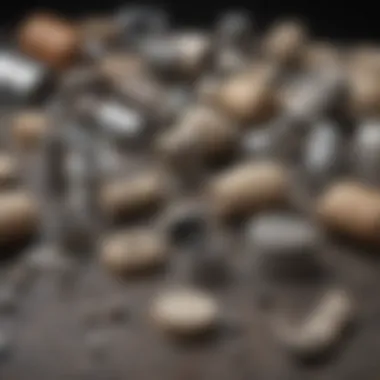
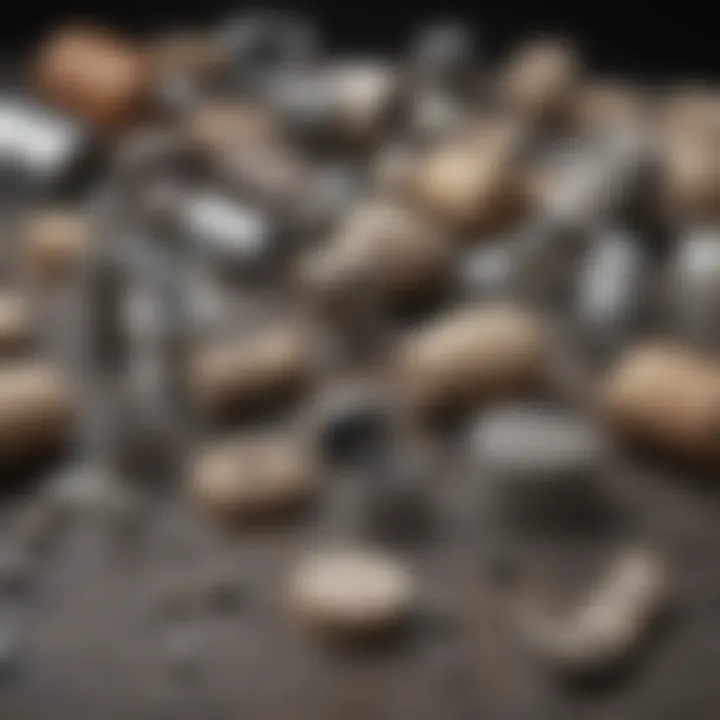
Application Techniques
Application techniques are crucial for maximizing the effectiveness and efficiency of Dremel diamond sanding drums. Proper techniques not only ensure the best results, but they also prolong the lifespan of the tools. This section will cover both basic operation procedures and advanced techniques, focusing on how to achieve optimal results while using these specialized tools. Understanding the correct application strategies can significantly impact outcomes, especially when working with intricate materials like collectibles, rocks, and fossils.
Basic Operation Procedures
Successful use of Dremel diamond sanding drums begins with a clear understanding of basic operational procedures. First, it is essential to securely attach the sanding drum to the Dremel rotary tool. Ensure that the drum is correctly tightened to prevent unintentional loosening during operation.
When starting, hold the tool firmly, using both hands for stability. Position the workpiece securely to avoid unwanted movement. Applying the right amount of pressure is vital; excessive force may cause overheating and premature wear on the drum, while too little pressure can lead to ineffective sanding.
- Select the Right Speed: Adjust the Dremel tool to the appropriate speed for the material you are working on. Generally, lower speeds are better for hard materials, while higher speeds suit softer materials.
- Establish a Steady Angle: Keep the sanding drum at a consistent angle to the surface. This ensures even sanding and avoids creating uneven surfaces.
- Use a Light Touch: Allow the diamond grit to do the work. A light touch minimizes the risk of damage and creates a smoother finish.
- Check Progress Frequently: Regularly stop to assess your progress. This helps prevent over-sanding and keeps you aligned with your desired outcomes.
By adhering to these basic operational procedures, users can effectively enhance their craftsmanship and achieve precise results.
Advanced Techniques for Effective Use
Once the basic techniques are mastered, advanced methods can enhance the effectiveness of Dremel diamond sanding drums. These techniques allow for greater precision and creativity, particularly when working on intricate designs.
- Layer Work: For achieving different finishes, consider working in layers. Start with a coarser drum for initial shaping, followed by finer drums for detailed work. This method is particularly effective for sculpting soft stones or fossils.
- Tilt and Rotate: Slowly tilt the drum and rotate it as you work on curves or detailed areas. This approach grants better access, allowing you to sand around contours and intricate shapes more effectively.
- Water Cooling: For materials that are prone to overheating, such as certain rocks and softer materials, using water can act as a coolant. It prevents overheating while also flushing away debris.
- Hand Guidance: Instead of solely relying on the Dremel’s control, use your hands to guide the material you are sanding rather than the tool itself. This method fosters a better feel for the workpiece and enhances your grip.
By implementing these advanced techniques, collectors and craftsmen can achieve superior results with their sanding projects, leading to higher-quality finishes.
Utilizing the correct technique can be the difference between a satisfactory finish and an exceptional one.
Safety Protocols
Safety protocols are critical when using Dremel diamond sanding drums. Working with power tools involves inherent risks, and Dremel tools produce high speeds that can increase hazards. Ensuring a safe environment not only protects the user but also enhances overall project outcomes. By adopting proper safety measures, enthusiasts can focus on their craftsmanship without the constant worry of potential accidents.
Personal Protective Equipment (PPE)
When engaging with sanding drums, it is essential to wear the correct Personal Protective Equipment. This includes:
- Safety goggles: To protect the eyes from dust and debris generated during sanding, goggles form a barrier against particles that may cause irritation or injury.
- Dust mask or respirator: Fine dust can be harmful when inhaled. A dust mask helps prevent respiratory issues, particularly when working with various materials that can produce fine particles.
- Hearing protection: Prolonged exposure to high-speed tools can damage hearing over time. Using earplugs or earmuffs is a practical way to safeguard hearing health.
- Gloves: While gloves protect hands from stinging debris, they must be handled cautiously. Gloves can also inadvertently get caught in moving parts.
In summary, the right PPE is non-negotiable for safe operation and should not be overlooked. Investing in quality gear is crucial for any serious collector.
Proper Workspace Setup
A proper workspace setup is another facet of safety that demands attention. An organized and clear work area plays a vital role in reducing accidents. Key considerations include:
- Clear surfaces: Ensure that work surfaces are free from unnecessary clutter. Spare tools, materials, and other accoutrements can distract or create hazards during operation.
- Proper lighting: Good visibility is paramount. A well-lit workspace helps in accurately observing the tool's movements and minimizes mistakes.
- Stable footing: Use a sturdy workbench or table. If standing, ensure that the floor is not slippery to avoid falls. Consider using an anti-fatigue mat to promote comfort during long working hours.
- Ventilation: Good air circulation helps disperse hazardous dust from sanding activities. If possible, work in a space equipped with a fume extraction system.
By prioritizing these areas, users can create a safer, more efficient environment that permits creativity and skill development without significant risk.
"Safety isn't just a priority; it's the foundation for quality craftsmanship."
Taking precautionary measures is an integral part of using Dremel diamond sanding drums effectively. Always stay alert and prioritize safety.
Maintenance and Care
Maintaining Dremel diamond sanding drums is crucial for their longevity and performance. Proper care ensures that these tools remain effective for various applications, particularly in the delicate work of shaping and smoothing rocks and fossils. Neglecting maintenance can lead to decreased efficiency, which can be detrimental when working with intricate materials. Below are key aspects that enhance the life and functionality of diamond sanding drums, ensuring they serve their purpose effectively.
Cleaning Methods
Cleaning your diamond sanding drums is essential to maximize their performance. Over time, diamond particles can accumulate debris and dust, which may hinder their cutting effectiveness. Here are simple yet effective cleaning methods:
- Brush Cleaning: Use a soft bristle brush to gently remove dust and particles from the drum surface. This is an excellent quick fix after every use.
- Ultrasonic Cleaner: For deep cleaning, consider using an ultrasonic cleaner. This device uses high-frequency sound waves in a cleaning solution to remove debris thoroughly.
- Soaking Method: Soak the drums in warm, soapy water for a few minutes, then scrub lightly with a soft cloth. Make sure to dry thoroughly before storage.
Ensuring the drums are clean prevents buildup, which can lead to overheating and ineffective use. Regular cleaning not only enhances performance but also extends the life of the sanding drums.
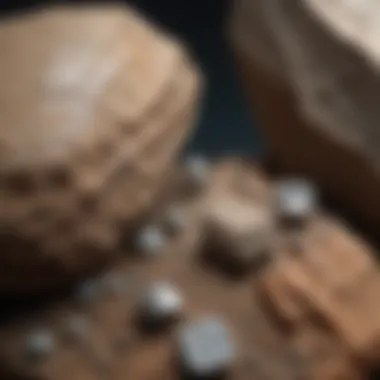
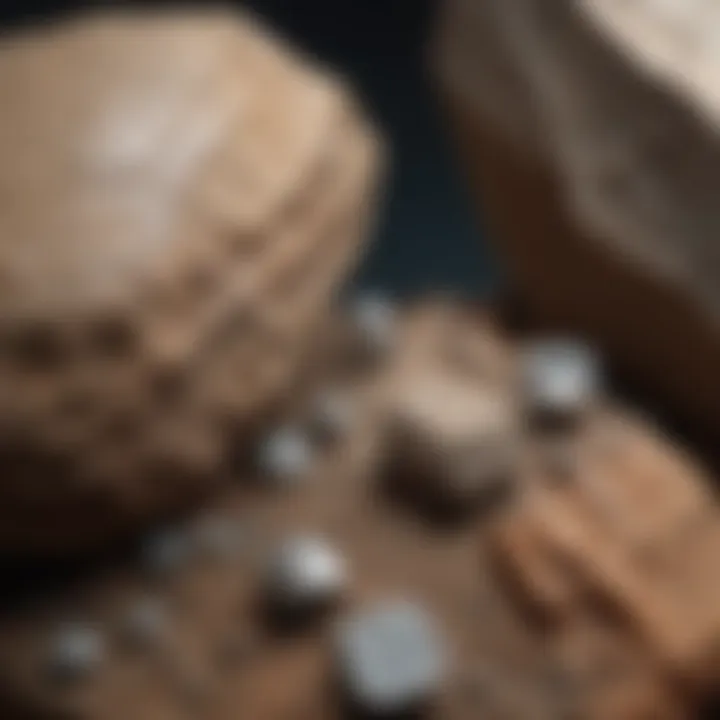
Storage Practices
Storing diamond sanding drums properly is as important as cleaning. Improper storage can result in damage or loss of their cutting ability. Consider these storage practices:
- Dry Environment: Keep the drums in a dry location to avoid rust or corrosion.
- Original Packaging: Whenever possible, store them in their original packaging or a dedicated tool box that prevents movement and impact.
- Separation from Other Tools: Store them away from other tools to prevent scratching or damaging the diamond surface. A dedicated drawer or container is ideal.
Proper storage not only protects the tools but also ensures they are ready for use when needed, significantly reducing downtime.
Implementing a good maintenance routine involving cleaning and appropriate storage will enhance the functionality and lifespan of your Dremel diamond sanding drums. This commitment to care not only saves money but also ensures that your projects achieve the best possible results.
Common Mistakes to Avoid
In the usage of Dremel diamond sanding drums, awareness of common mistakes can significantly enhance the quality of work and prolong tool lifespan. Missteps in application or technique not only diminish the effectiveness of the sanding drums but can also lead to damage on both the workpiece and the tool. Understanding such errors allows users to refine their approach and achieve better results while minimizing potential risks.
Overheating and Its Consequences
Overheating is a frequent issue encountered by users of diamond sanding drums. When the drum overheats, it can result in several adverse effects. Primarily, it may lead to a loss of diamond particles from the drum, reducing its effectiveness. Moreover, overheating can burn or warp the material being worked on, further compromising the quality of the final product. The excessive heat generated can also negatively impact the Dremel tool itself, potentially leading to malfunctions or permanent damage.
To prevent overheating, it is crucial to use appropriate speeds for the specific material. Slower speeds are often more effective for harder materials, while softer materials can be sanded at higher speeds. Taking regular breaks can also be beneficial; this allows both the drum and the workpiece to cool down, enhancing overall durability. Furthermore, users should ensure that the workpiece is securely held in place, as improper handling can contribute to excessive friction and heat.
Tip: Always monitor the temperature of both the drum and the workpiece during use to avoid overheating. If the drum feels too hot to touch, take a break.
Misapplication of Drums
Misapplication refers to using the wrong type of diamond sanding drum for a specific task. This issue often emerges from a lack of familiarity with the different types of drums available. For instance, using a drum designed for shaping on a smoother finishing task can yield unsatisfactory results. This misalignment can lead to increased wear on the drum, poor surface finish, and unsatisfactory completion of the project.
To avoid misapplication, users must carefully assess their project requirements before selecting a drum. Consider the size, grit, and intended use of the drum. For example, finer grits are appropriate for detailed work, while coarser grits are better suited for aggressive material removal. Additionally, consultation with product manuals or expert resources can provide valuable guidance on drum selection, ensuring that users match the right drum with their specific tasks.
In summary, avoiding overheating and correct application of sanding drums can greatly increase effectiveness and enhance user experience. Being attentive to these common mistakes allows collectors and hobbyists to get the most out of their Dremel diamond sanding drums.
Innovations and Future Trends
Innovations and future trends are crucial for anyone interested in Dremel diamond sanding drums, especially those using them for collectibles, rocks, and fossils. This section outlines both technological advancements and market trends that shape the usability and effectiveness of these tools. Understanding these innovations can help users select the right products for their specific needs and improve their overall experience.
Technological Advancements in Diamond Drums
The development of Dremel diamond sanding drums has progressed significantly in recent years. New technologies have improved design and performance, enhancing precision and durability. Some important advancements include:
- Enhanced Abrasive Technology: The use of synthetic diamond particles has become more advanced. This leads to better grinding efficiency and longer-lasting performance.
- Vibration Reduction Features: Modern diamond sanding drums often feature designs that minimize vibration during operation. This results in better control and a smoother finish when working on delicate materials.
- Compatibility with Various Tools: Newer models offer improved compatibility with a variety of Dremel rotary tools. This opens up greater flexibility for users.
- Eco-friendly Options: Innovations also focus on environmental impact. Some brands are now producing diamond sanding drums that prioritize recyclable and sustainable materials.
These advancements not only increase efficiency but also make the sanding process more enjoyable. Users can now achieve finer details in their work while reducing fatigue and wear on both the tool and the material being worked on.
Market Trends and User Preferences
As technology evolves, so do market trends and user preferences. Specific patterns emerge in connection with what consumers seek when purchasing Dremel diamond sanding drums. Key trends include:
- Demand for Versatility: Users are looking for tools that can handle multiple tasks and materials. Versatile diamond drums are highly sought after for their ability to perform well on various surfaces, from soft minerals to hard gemstones.
- Focus on User Education: There is an increasing need for comprehensive instructional materials. Users often prefer brands that offer additional guidance on usage, safety protocols, and maintenance.
- Customized Products: There is a trend towards more personalized tools. Buyers appreciate options that allow them to choose size, grit, and type according to their specific projects.
- Online Marketplaces: The rise of digital commerce has influenced buying behavior. Collectors and hobbyists often turn to platforms like Reddit and Facebook to share their experiences and recommendations regarding specific brands and products.
Understanding these trends allows manufacturers to cater to the evolving demands of their customers. As a result, they can tailor products more effectively, meeting specific needs that contribute to a more successful user experience.
Culmination
In concluding this guide, it is crucial to recognize the significance of understanding Dremel diamond sanding drums in the context of practical applications for rock and fossil collectors. This article has emphasized several key aspects that shape the user’s experience and outcomes when utilizing these tools.
First, the choice of the right diamond sanding drum can dramatically affect the quality of the work. Knowledge of the different types available, such as standard and specialized drums, allows users to tailor their approach based on the specific requirements of the material they are working with.
Second, the insights into application techniques cannot be overlooked. Proficient operation of these tools can lead to better finishes and greater efficiency during projects. By practicing basic and advanced techniques, users improve their skills and achieve higher detail in their work.
Safety protocols, which were also highlighted, are indispensable. Wearing the appropriate personal protective equipment and ensuring a well-organized workspace are fundamental to preventing accidents, thus making the sanding process safer.
Moreover, consistent maintenance of the diamond sanding drums is not just about prolonging the lifespan of the tools. Regular cleaning and proper storage practices greatly impact the effectiveness and performance of the drums.
"Investing time in selecting the right tools and techniques can ultimately enhance the quality and enjoyment of collectibles projects."
Finally, following the common mistakes to avoid ensures that users do not fall into traps that could hinder their progress. Overheating issues and misapplied techniques can derail efforts and waste valuable materials.
In summary, mastering Dremel diamond sanding drums not only optimizes practical applications but also elevates the overall experience of rock and fossil collectors. By integrating these considerations into their practices, users can greatly enhance both their skill set and the quality of their work.



